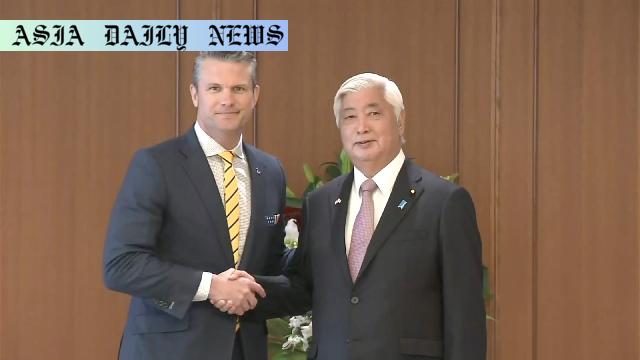Bilateral Alliance: Japan and the US discuss enhancing their defense partnership with coordinated operations and advanced strategies.
The defense ministers of Japan and the US met in Tokyo to enhance bilateral alliance strategies.
Discussions addressed joint exercises, command structure upgrades, and China’s military rise in the East China Sea.
Commitment was reaffirmed to deepen cooperation in equipment, technology, and defense spending strategies.

Japan and US Commit to Strengthening Bilateral Alliance
The defense ministries of Japan and the United States convened in Tokyo to underscore their dedication to a reinforced strategic partnership. This meeting marked a significant evolution in the bilateral alliance between the two nations, as Japanese Defense Minister Nakatani Gen and US Defense Secretary Pete Hegseth collaborated to better coordinate the operations of Japan’s Self-Defense Forces (SDF) and the US military. Highlighting their mutual focus on the Indo-Pacific’s stability, the discussions resulted in a shared commitment to a free and open region.
Focus on Advanced Coordination and Joint Command Structures
Central to the talks were key initiatives to improve the coordinated efforts of their military operations. The recent establishment of the SDF Joint Operations Command reflects a strategic shift, unifying leadership across its branches and elevating command and control capabilities. The defense leaders also envisioned creating a Joint Force Headquarters, a vital entity that would enable US forces stationed in Japan to gain operational command, streamlining their combined efforts. Such developments are set to enhance military readiness, adaptability, and effective response during both peacetime and emergencies.
Addressing Regional Security Challenges in East Asia
The conversation took a decisive turn as the two leaders discussed increasing their collective presence in Southwest Japan, particularly in light of China’s growing military activities in the East China Sea. Nakatani and Hegseth agreed upon boosting joint military exercises and operational readiness to counteract emerging threats in the region. By enhancing their collective ability to deter potential adversaries and respond quickly to security threats, Japan and the US signaled their unwavering resolve to maintain peace and stability.
Innovation in Equipment, Technology, and Defense Capabilities
In addition to operational alignment, the bilateral discussions moved forward on topics of technological and equipment cooperation. Both defense ministries committed to leveraging their advanced capabilities to strengthen their defense infrastructure. By sharing critical technological advancements and insights, the two countries aim to improve their strategic deterrence capabilities, focusing not just on quantity but also on the quality of their resources.
Commitment to Shared Responsibilities and Defense Spending
A substantial portion of the dialogue ventured into the realm of defense spending and resource allocation. Nakatani reiterated Japan’s goals to focus on strategically reinforcing its defense capabilities autonomously while maintaining robust collaboration with the US. The US delegation expressed support, emphasizing the importance of quality over quantity in military investments. This joint strategy is expected to set a framework for increased military effectiveness and accountability.
A Strategic Alliance for a Global Vision
With growing complexities in the region’s security environment, Japan and the US have reaffirmed their enduring commitment to enhancing their alliance’s deterrence and response capabilities. Strategic joint exercises, shared technological breakthroughs, and an increased presence in critical regions illustrate the alliance’s evolution. This meeting underscored their shared responsibility for preserving regional harmony and global peace, marking a new chapter in their collaborative efforts toward achieving long-term stability.



Commentary
The Significance of a Strengthened Japan-US Alliance
The bilateral meeting between Japan and the United States defense leaders highlights a pivotal moment in their growing alliance. As global tensions rise and regional security challenges intensify, collaborations such as these act as vital elements to maintain stability and deter aggression. This meeting not only symbolizes mutual trust but also reflects the urgency of collective action against common threats, particularly in the Indo-Pacific region.
Strategic Focus and Regional Implications
Undoubtedly, the emphasis on establishing joint command structures and operational readiness marks a significant stride. In doing so, both countries demonstrate their intention to adapt to rapidly evolving security dynamics, especially with China’s military assertiveness in the East China Sea. The decision to improve real-time coordination also signals an acknowledgment of today’s sophisticated warfare demands, where outdated command models are no longer sufficient to guarantee an advantageous position during crises.
Balancing Sovereignty and Shared Goals
One of the most enlightening aspects of the meeting is Japan’s emphasis on pursuing autonomy in its defense capabilities while integrating with a larger framework of US collaboration. This nuanced approach asserts Japan’s sovereignty and ability to make independent strategic decisions while still benefiting from the strength and experience of its ally. Such a balance is essential to establishing a partnership rooted in mutual respect and shared values.
Preparation for the Future
As both countries move toward a united vision where defense cooperation becomes even more dynamic and multifaceted, the decisions made during this meeting set the stage for the future. From technological advancements to enhanced joint exercises, these tangible actions pave the way for greater security in troubled times. Both Japan and the US have reiterated that peace and stability in the Indo-Pacific region remain top priorities, making their alliance a critical component in achieving these goals.